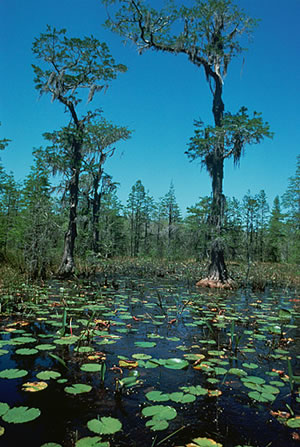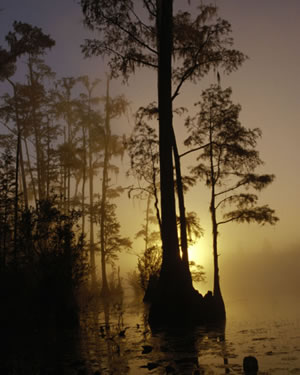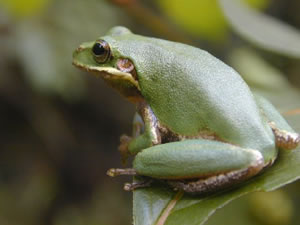The Okefenokee Swamp is North America's largest swamp.
When the Atlantic Ocean receded from southeastern Georgia and Florida, it left a lake of salt water in a shallow, saucer-shaped depression. Layers of clay and silt accumulated on the limestone bed, while on top of these decaying vegetation turned to peat.
 Today the water resembles tea, stained by the tannic acid from cypress trees and peat.
Today the water resembles tea, stained by the tannic acid from cypress trees and peat.
However, the water is not stagnant. Water from several natural springs moves slowly toward and along two rivers. The St. Mary's leads to the Atlantic and the Suwannee flows into the Gulf of Mexico.
Plants
The brown water of the Okefenokee is rarely more than lm (3.3ft) deep. Because it is so shallow, many plants, such as water lilies and floating hearts, can root in the mud and push their stems to the air and sunlight.
Swamp cypress trees grow in large clusters throughout the swamp and are well-adapted to survive in the soggy, unstable soil. They are often covered with Spanish moss.
 The cypress tree's base flares out to form many buttresses, allowing the tree to spread its weight over a large area of mud. Because the roots cannot obtain oxygen from the waterlogged soil, they send up nodules, or "knees" through the water to the air.
The cypress tree's base flares out to form many buttresses, allowing the tree to spread its weight over a large area of mud. Because the roots cannot obtain oxygen from the waterlogged soil, they send up nodules, or "knees" through the water to the air.
It may take a thousand years for a cypress to reach old age. A mature tree will eventually grow too large for the mud that supports it and is likely to topple over during high winds. However, the cypress will not die as long as its root system stays intact. Branches will grow up from the trunk, prolonging the life of the fallen giant by many years.
Throughout the Okefenokee, strange islands float in the forests and in the open marshes or "prairies" where maiden cane grass grows in profusion.
Composed either of peat or of tree branches, matted moss and grass tangle together to form rafts.
Animals
An enormous variety of animals can thrive in Okefenokee Swamp. These include snakes, lizards, turtles, frogs, toads, ospreys and herons.
The alligator is a formidable resident of the swamp. Its young are only 10cm (4in) long when they hatch yet they hunt at once, voraciously feeding on any frog, fish or insect they can tackle.
Full-grown alligators may reach 4m (13ft) in length and weigh 225kg (4961bs).
The swamp provides ideal conditions for amphibians, which need to lay their eggs in an aquatic environment.
The southern leopard frog inhabits rich low-lying vegetation.
 The squirrel tree frog is only 2.5cm (1in) long and can change its color to suit its environment. Its flattened toes are specially adapted for climbing cypress trees.
The squirrel tree frog is only 2.5cm (1in) long and can change its color to suit its environment. Its flattened toes are specially adapted for climbing cypress trees.
The yellow-bellied sapsucker is a woodpecker that makes the swamp its home. It drills rows of holes in the trunks of trees, then later returns to drink the sap and feed on the insects.